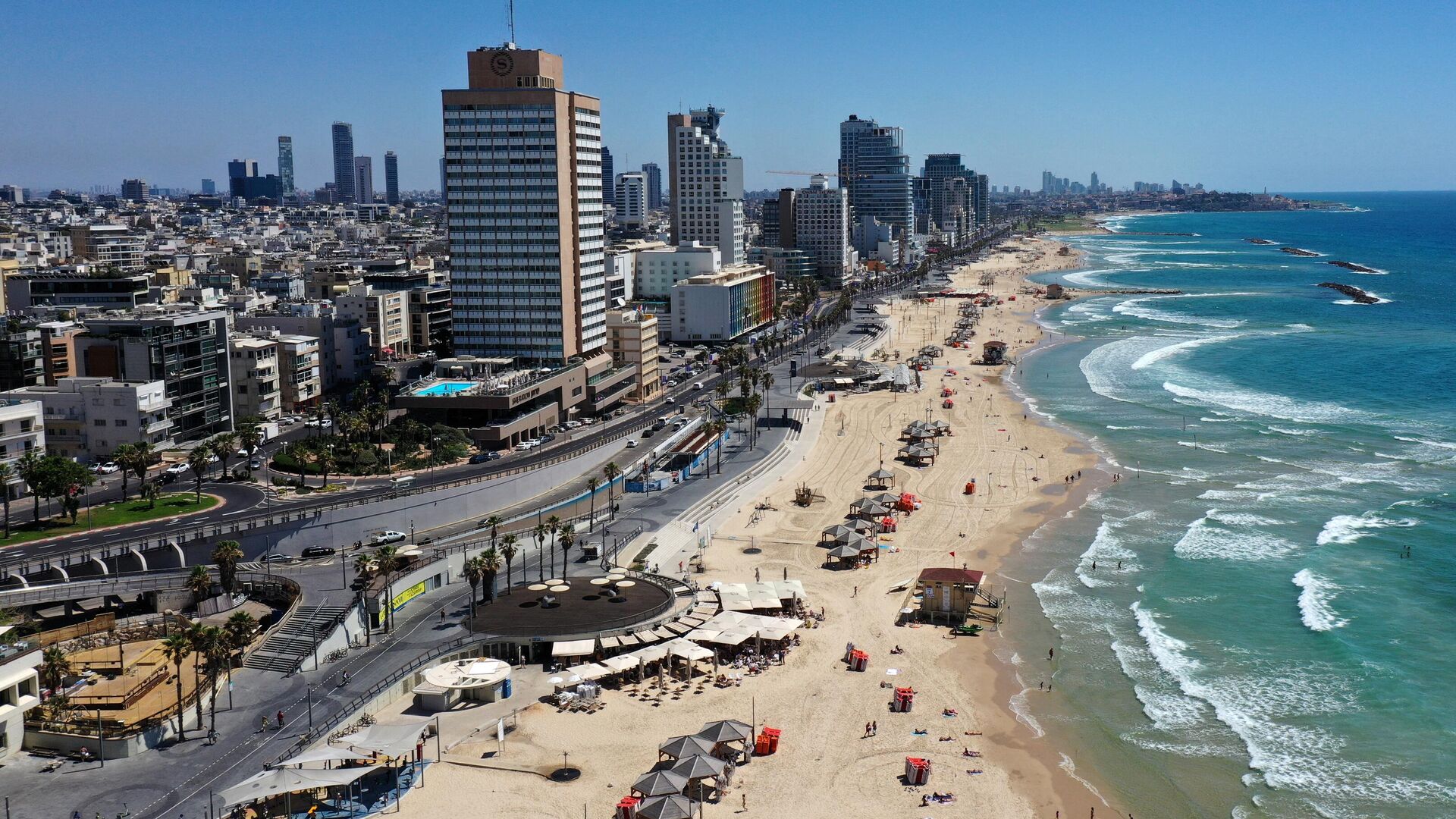https://sputnikglobe.com/20231126/whats-behind-israels-financial-might-1115218296.html
What’s Behind Israel’s Financial Might?
What’s Behind Israel’s Financial Might?
Sputnik International
Last year, Israel's gross domestic product (GDP) soared to $501 billion and is estimated to increase to $611 billion by 2026. So what factors add to Israel’s state coffers refilled? Sputnik explores.
2023-11-26T17:19+0000
2023-11-26T17:19+0000
2023-11-26T17:19+0000
economy
israel
us
economy
crisis
development
research
investments
https://cdn1.img.sputnikglobe.com/img/07e7/0b/1a/1115217293_0:0:3228:1816_1920x0_80_0_0_614a7e665edf74593aaa8eb6ec166e3f.jpg
Israel’s per capita income now stands at $58,273, the second-highest in the Middle East after Qatar ($83,890), according to the International Monetary Fund’s World Economic Outlook database. This is a large jump from the 1980s, when the state was hit by an array of economic hardships, including hyperinflation and a heavy reliance on imports and the country’s per capita income was valued at just about $6,600.US AidWashington’s commitment to aiding Tel Aviv has long-standing roots, dating back to May 14, 1948, when the US was the first country to recognize Israel as an independent state.According to open sources, the US has provided Israel with more than $260 billion in combined military and economic aid since then, also giving about $10 billion more in contributions for Israeli missile defense systems like the Iron Dome.In 2016, then-US President Barack Obama signed an agreement on an overall package of $38 billion in military aid to Israel between 2017 and 2028.The US’ drive to give so much to Israel can be attributed to a spate of factors, including America’s historic obligations dating back to the above-mentioned support for the creation of the Jewish state in 1948. Additionally, the US perceives Israel as a crucial ally in the Middle East, which shares its goals and has a mutual commitment to what Washington calls “democratic values.”The US government's foreign assistance agency, in turn, said that the American aid "helps ensure that Israel maintains its Qualitative Military Edge (QME) over potential regional threats." The agency added that the goal is to ensure that Israel is "sufficiently secure to take the historic steps necessary to reach a peace agreement with the Palestinians and for comprehensive regional peace."Economic Crisis Turned Success?In an interview with an Indian online newspaper, Professor Tomer Fadlon, lecturer and academic adviser for the master’s program in cyber, politics and government at Tel Aviv University, pointed out that Israel’s history reflects "a success story of a nation that faced a severe crunch of resources."Pumping in R&DThe professor pointed to the liberalization of the Israeli economy in 1985 as part of economic reforms, which came after an economic meltdown in the state in previous years, when Israel’s government spent a lot on defense. According to him, one of the positive outcomes of the economic liberalization was Israel’s push to invest into research and development (R&D).He added that in the early 1990s, Israel started to spend a lot on research and development. "Consequently, the spending on R&D as a share of GDP increased dramatically to 5% and created a gap between Israel and other countries,” the professor said.By 2021, Israel’s expenditure on R&D had jumped to 5.6% of GDP, which is the highest in the world and is followed by South Korea (4.9%) and Taiwan (3.8%), per estimates by the Organization for Economic Cooperation and Development (OECD).High-Tech ExportsMany attribute an increase in Israel’s per capita income after 2006 to export large volumes of high-quality technology at the time.The UN Comtrade (a repository of global trade statistics) defines high technology exports as "products with high R&D intensity, such as in aerospace, computers, pharmaceuticals, scientific instruments, and electrical machinery."The Israel Innovation Authority’s data indicates that the country ranks first in the world for percentage of GDP from high-tech industries (15%) and percentage of the workforce in high-tech (10%).Tourism Tourism in Israel remains one of the country's major sources of income, with revenue expected to reach a total of $3.48 million before the end of this year, per official statistics. The figure is projected to rise to $4.45 million by 2027.According to Israeli sources, the state has had 2.5 million tourist entries in 2023 so far, while Israel saw the largest tourist influx with 4.9 million visitors in 2019.The ratings firm S&P Global has meanwhile claimed that a likely halt of foreign tourism in Israel due to the country’s current armed conflict with the Palestinian militant group Hamas may have “minimal” impact on the Jewish state’s economy.
https://sputnikglobe.com/20231019/how-much-aid-does-us-give-to-israel-1114314071.html
https://sputnikglobe.com/20220301/israel-opens-up-to-foreign-visitors-but-will-it-be-enough-to-revive-tourism-from-covid-19-1093470256.html
israel
Sputnik International
feedback@sputniknews.com
+74956456601
MIA „Rossiya Segodnya“
2023
Oleg Burunov
https://cdn1.img.sputnikglobe.com/img/07e4/09/0b/1080424846_0:0:2048:2048_100x100_80_0_0_3d7b461f8a98586fa3fe739930816aea.jpg
Oleg Burunov
https://cdn1.img.sputnikglobe.com/img/07e4/09/0b/1080424846_0:0:2048:2048_100x100_80_0_0_3d7b461f8a98586fa3fe739930816aea.jpg
News
en_EN
Sputnik International
feedback@sputniknews.com
+74956456601
MIA „Rossiya Segodnya“
Sputnik International
feedback@sputniknews.com
+74956456601
MIA „Rossiya Segodnya“
Oleg Burunov
https://cdn1.img.sputnikglobe.com/img/07e4/09/0b/1080424846_0:0:2048:2048_100x100_80_0_0_3d7b461f8a98586fa3fe739930816aea.jpg
israel's state coffers, jewish state's high-tech exports, israel's r&d, us' hefty contributions to israel, economic reforms in israel, tourism in israel, jewish state's gross domestic product
israel's state coffers, jewish state's high-tech exports, israel's r&d, us' hefty contributions to israel, economic reforms in israel, tourism in israel, jewish state's gross domestic product
What’s Behind Israel’s Financial Might?
Israel's gross domestic product (GDP) soared to $501 billion last year and is estimated to increase to $611 billion by 2026. The state is now touted as the world’s 29th-largest economy in terms of GDP. So what adds to Israel’s state coffers? Sputnik explores.
Israel’s per capita income now stands at $58,273, the second-highest in the Middle East after Qatar ($83,890), according to the International Monetary Fund’s World Economic Outlook database.
This is a large jump from the 1980s, when the state was hit by an array of economic hardships, including hyperinflation and a heavy reliance on imports and the country’s per capita income was valued at just about $6,600.
Various sources credit Israel’s current financial might to an array of crucial factors, including the US’ hefty contributions, measures taken in the aftermath of the economic crisis in the early 1980s, heavy investment in research and development, export of high technology and a prospering tourism industry.
Washington’s commitment to aiding Tel Aviv has
long-standing roots, dating back to
May 14, 1948, when the US was the first country to recognize Israel as an independent state.
According to open sources, the US has provided Israel with more than $260 billion in combined military and economic aid since then, also giving about $10 billion more in contributions for Israeli missile defense systems like the Iron Dome.
In 2016, then-US President Barack Obama signed an agreement on an overall package of $38 billion in military aid to Israel between 2017 and 2028.

19 October 2023, 16:30 GMT
The US’ drive to give so much to Israel can be attributed to a spate of factors, including America’s historic obligations dating back to the above-mentioned support for the creation of the Jewish state in 1948. Additionally, the US perceives Israel as a crucial ally in the Middle East, which shares its goals and has a mutual commitment to what Washington calls “democratic values.”
According to the US Congressional Research Service, America’s "foreign aid has been a major component in cementing and reinforcing these [Tel Aviv-Washington] ties. US officials and many lawmakers have long considered Israel to be a vital partner in the region."
The US government's foreign assistance agency, in turn, said that the American aid "helps ensure that Israel maintains its Qualitative Military Edge (QME) over potential regional threats." The agency added that the goal is to ensure that Israel is "sufficiently secure to take the historic steps necessary to reach a peace agreement with the Palestinians and for comprehensive regional peace."
Economic Crisis Turned Success?
In an interview with an Indian online newspaper, Professor Tomer Fadlon, lecturer and academic adviser for the master’s program in cyber, politics and government at Tel Aviv University, pointed out that Israel’s history reflects "a success story of a nation that faced a severe crunch of resources."
"It’s that scarcity coupled with an economic crisis that made us look for better and beyond, and look for avenues to grow. Scarce resources made us work harder, and that sums up all the economic success that has followed," he underlined.
The professor pointed to the liberalization of the Israeli economy in 1985 as part of economic reforms, which came after an economic meltdown in the state in previous years, when Israel’s government spent a lot on defense. According to him, one of the positive outcomes of the economic liberalization was Israel’s push to invest into research and development (R&D).
"[…] Israel opened the gates for foreign direct investment (FDI), and government spending on security and defense came down from about 25% of GDP to around 5-6%," Fadlon stressed.
He added that in the early 1990s, Israel started to spend a lot on research and development. "Consequently, the spending on R&D as a share of GDP increased dramatically to 5% and created a gap between Israel and other countries,” the professor said.
By 2021, Israel’s expenditure on R&D had jumped to 5.6% of GDP, which is the highest in the world and is followed by South Korea (4.9%) and Taiwan (3.8%), per estimates by the Organization for Economic Cooperation and Development (OECD).
Fadlon noted in this regard that "We [Israel] were lucky we spent (on) research way before everyone else and, by the time information technology boomed, we had already achieved comparative advantage."
Many attribute an increase in Israel’s per capita income after 2006 to export large volumes of high-quality technology at the time.
The UN Comtrade (a repository of global trade statistics) defines high technology exports as "products with high R&D intensity, such as in aerospace, computers, pharmaceuticals, scientific instruments, and electrical machinery."
According to UN Comtrade data, Israel’s high-tech exports were worth $3.12 billion in 2007, with subsequent years seeing the figure gradually increase. In 2021, Tel Aviv exported a whopping $17 billion worth of high technology, which was about a third of its manufactured exports. The state’s other exports pertain to cut diamonds, refined petroleum, agricultural products, chemicals, textiles and apparel.
The Israel Innovation Authority’s data indicates that the country ranks first in the world for percentage of GDP from high-tech industries (15%) and percentage of the workforce in high-tech (10%).
Tourism in Israel remains one of the country's major sources of income, with revenue expected to reach a total of $3.48 million before the end of this year, per official statistics. The figure is projected to rise to $4.45 million by 2027.
According to Israeli sources, the state has had 2.5 million tourist entries in 2023 so far, while Israel saw the largest tourist influx with 4.9 million visitors in 2019.
The ratings firm S&P Global has meanwhile claimed that a likely halt of foreign tourism in Israel due to
the country’s current armed conflict with the Palestinian militant group Hamas may have “minimal” impact on the Jewish state’s economy.





